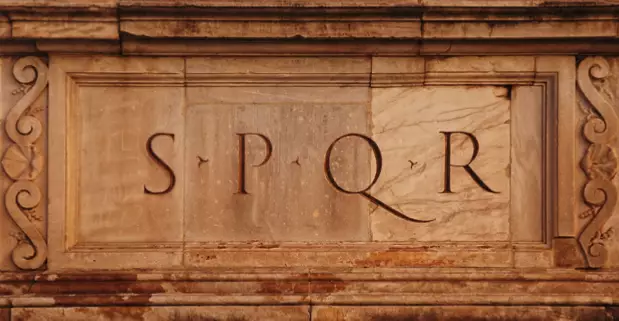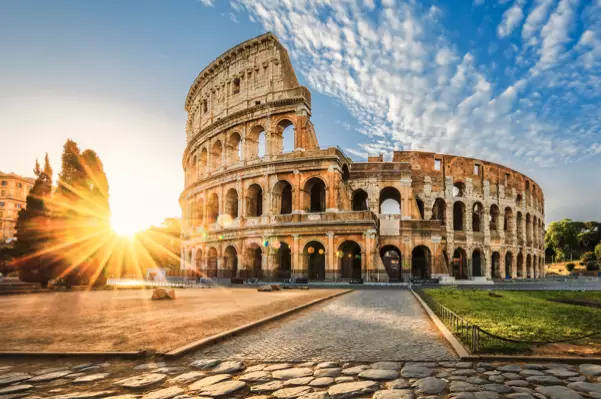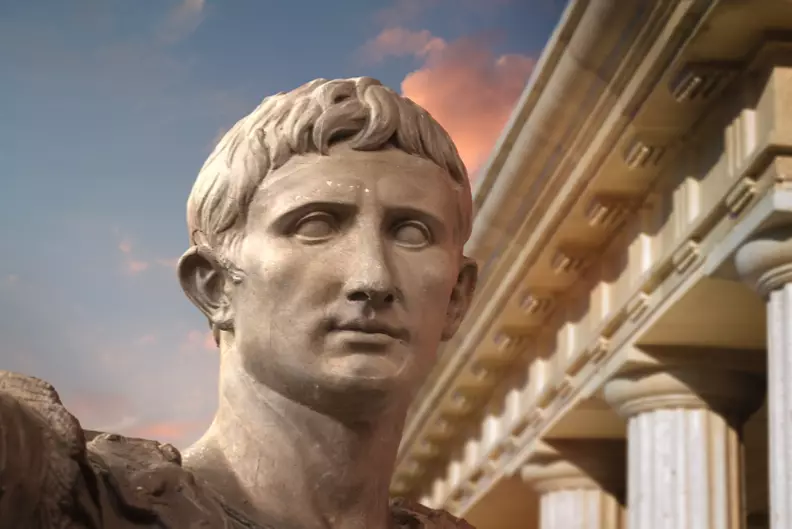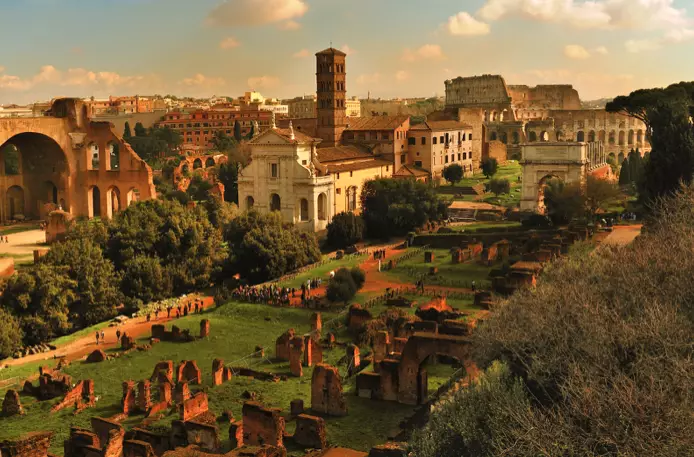All Roads Lead to Rome - Engaging with Ancient Rome through Literature
Introduction | Background Knowledge | Activities | Extensions | Standards

Introduction
"To fiddle while Rome burns." "Rome was not built in a day." "When in Rome, do as the Romans do." "All roads lead to Rome." These are words that many Americans regularly use in conversation. They all come from the period of Ancient Rome, which permeates our modern lives in many ways

Click the image above to view a video that shows more about Ancient Rome.
Background Knowledge
According to myth, Rome was founded on April 21, 753 BCE. Twin brothers, Romulus and Remus, were born in central Italy along the banks of the Tiber River. The babies were descended from Mars, the god of war. The king demanded that they be drowned in the river, but they were saved and nursed by a she-wolf. When they came of age, Romulus and Remus founded their own city. The brothers argued, either over the location of the city or the name, and Romulus killed Remus, and thus Rome was born.
The earliest Roman settlement was known as the Kingdom of Rome. Archeologists date the village to its founding in the 8th century BCE but could be as far back as the 10th century BCE. Romulus was the first king of Rome.The six kings who would follow were elected by the Senate. There was not a hereditary line to the throne. Many kings were kind and gracious, but the seventh king, Lucius Tarquinius Superbus, known as Tarquin the Proud, was different from his predecessors. Historians remembered him as a cruel tyrant. When he was overthrown after a scandal in 509 BCE, the monarchy ended, and Rome transitioned to a Republic.
With the end of the monarchy in 509 BCE, the Romans looked to a new system. So they established a republic of elected officials, or magistrates, and other representative bodies. The Republic had a system of rules, norms, and customs that were recorded together in a constitution. This constitution established a separation of powers and a system of checks and balances. The executive power was reserved for the highest elected officials, called consuls. They worked in tandem with the Senate, created as an advisory council, but grew in power and influence.
Gauls attacked the Romans during the 4th Century BCE. The Gallic army defeated the Romans outside the city and marched into Rome unchallenged. While most of the population had fled the city, some took refuge on Capitoline Hill to try and protect their city. The Gauls burned Rome and took Capitoline Hill under siege. The siege lasted for 7 months, when the Gauls offered peace in exchange for 1000 pounds of gold. This encouraged the Romans to gradually take over other people living on the Italian peninsula. These conquests allowed the Romans to take control of the lands they conquered.
In the 3rd century BCE, the Carthaginians, an empire with control of the Mediterranean Sea, and the Romans began to clash over control of the Mediterranean Sea. This conflict led to three major conflicts known as the Punic Wars. These wars spanned 115 years (from 264 BCE to 149 BCE) and led the Romans to develop a navy and a maritime strategy to defeat the strong Carthaginians at sea. By the end of the Second Punic War, the Romans had shifted their sights from Carthage to Greece and Hispania. When Carthage engaged in conflict with Numidia without Roman permission, Rome declared war on Carthage, starting the Third Punic War in 149 BCE. The Roman military destroyed Carthage, enslaved its people, and took control of the area, solidifying its power.
During the 2nd century BCE, the Romans conquered the Ancient Greeks and, merging of the two cultures began. After that success, Rome had very few adversaries in the region. Because there were no enemies abroad, conflict began inside the Roman government. The Senators continued to gain wealth on the backs of the soldiers and farmers. The Senators tried to keep order by using violence. The Gracchi Brothers, tribunes who tried to give land to common people, were killed and the Senators reversed their work. This caused a greater divide between the classes.
In the mid-1st century, Rome had solidly split into two political factions. One was for the people, and the other wanted to maintain aristocratic control. Roman politics were in an era of chaos. From that chaos, Gaius Julius Caesar emerged as the leader. He brought two other men into his circle, calling themselves the First Triumvirate. Crassus was the richest man in Rome and built wealth as he enjoyed military command. Magnus (also known as Pompey), who was Caesar's father-in-law, continued his role in the Senate. Caesar served as the consul, the highest elected officer in Rome, and had command of the military in Gaul. The First Triumvirate worked well together to lead Rome until the collaboration unraveled. When Caesar's wife died in childbirth, the relationship with Pompey deteriorated. Crassus was killed at the Battle of Carrhae. As Crassus had been the mediator between Caesar and Pompey, the two men began to jockey for control upon his death. Caesar invaded Rome and fought the Battle of Pharsalus, the first of many that would take power from the political faction that favored aristocratic rule. Pompey was killed in 48 BCE, leaving Caesar as the ultimate leader. On the Ides of March (March 15) of 44 BCE, Julius Caesar was assassinated by a group of Senators known as the Liberatores.
After Caesar's assassination, Rome entered a period of turmoil. Marcus Antonius (Mark Antony) ruled the city until Caesar's adopted son, Octavian, arrived. The two men, along with Caesar's best friend, Marcus Lepidus, formed the Second Triumvirate in 43 BCE. During the five-year alliance, the Second Triumvirate executed any senator who was believed to be a supporter of the Liberatores. In 42 BCE, supported by Antony and Octavian, the Senate deified Caesar and Octavian became known as the Divi filius, son of the deity. The Triumvirate was set to expire in 38 BCE but was renewed for an additional five years. By that time, the relationship between Octavian and Antony had turned, and Lepidus defied Octavian and was forced to resign. Antony was living in Egypt with Cleopatra. Octavian considered this treason, and the two men went to battle in the Battle of Actium in 31 BCE. Egypt was decimated, Antony and Cleopatra committed suicide, and Rome conquered Egypt.
At the age of 36, Octavian was the sole ruler of Rome. He established the Julio-Claudian dynasty. In 27 BCE, he took the name Augustus. He consolidated all of the ruling powers into one position called the Princeps. His time was peaceful as he maintained total control. He limited the power and influence of the Senators and ruling class. He increased the wealth and impact of the equestrian class, the class just below the Senators. He created a standing army and stayed away from the battlefields, leaving any fighting to his military commanders. The time of relative peace allowed the arts to flourish, and the great Roman poets - Virgil, Ovid, Horace, Rufus - emerged during Augustus's reign. He also made changes to the calendar, and the month of August is named after him. He died in 14 BCE. The Julio-Claudian dynasty stayed in power until Nero died in 68 CE.
The Flavian Dynasty came to power upon Nero's death in 68 CE. The leaders of the Flavian Dynasty continued to expand Rome's control of the region and maintained its strength. This dynasty led Rome for 28 years.
The Nerva-Antonine Dynasty (96 - 192 CE) was a time of peace for the Roman Empire. The emperor was chosen for his leadership qualities instead of his bloodline. Under Trajan in 117 CE, Rome was the largest that it would be in terms of landholdings. The last emperor of the Nerva-Antonine Dynasty, Commodus, was killed in 192 CE.
193 CE was a time of transition for Rome. Known as the Year of Five Emperors, Rome cycled through leaders, and the people were not happy with the way they were led. This was a time of war and conflict, both inside Rome and abroad. The turmoil continued. There were 26 emperors in 49 years. Many of the 26 emperors served only a short time and were more concerned about their power and influence than the power and influence of Rome. The cost of the many military conflicts caused the economy to crash. The coin was devalued, and inflation came suddenly and quickly. With a new Emperor in 284 CE., the Crisis of the Third Century was finally overcome.
Emperor Diocletian came to power in 284 CE. He instituted a system of government called the Tetrarchy. In a Tetrarchy, the control was divided among two senior emperors and their designated successors. Under the Tetrarchy, many capitals were established by its members. Diocletian also persecuted Christians, destroying many churches and forbidding worship. In 305 CE, Diocletian became the first Roman monarch to abdicate.
Constantine became a tetrarch in 306 CE. He went to war against other tetrarchs. In 313 CE, he issued the Edict of Milan. The Edict of Milan allowed Christians to worship freely. Constantine converted to Christianity, beginning Europe's shift as well. After him, Julian came into power and moved the capital to Constantinople.
In the 4th and 5th centuries, Rome began its descent. Historians pinpoint 476 CE as the Fall of Rome. From 330 CE through the Fall of Rome, the civilization was constantly at war. The conflicts culminated when Romulus Augustus was overthrown.
Rome was an independent civilization for 1200 years and was a world power for 700 years. The culture left a legacy that can be seen in many modern societies. Much of America's government - the representative model, separation of powers, and the three branches of government - are modeled after the government of Rome. Many legal practices came from Rome. Latin is the foundation for the Romance languages, and English incorporates many Latin roots. Romance languages and English use the Roman alphabet. In the later years of the empire, Rome spread Christianity around the world and would become the seat of the Catholic Church.

ACTIVITIES
-
Paolo, Emperor of Rome by Mac Barnett (ISBN 9781419741098)
- Paolo, the dog, has escaped from the hair salon where he lives. He runs around Rome and sees the sights as he enjoys his freedom. This book is great to introduce students to many sights in Rome and can be a springboard to the past.
- Write a postcard home from Paolo's point of view! Ask students to add information that they learned about the various sights in Rome and their historical significance.
- Create a virtual travel guide of Ancient Rome using CapCut (TeachersFirst review), where students can record themselves sharing details about places to visit around the city/republic.
- Mac Barnett reads Paolo, Emperor of Rome here.
- See Rome Reborn (TeachersFirst review) and follow Paolo's journey of how it would have been during the ancient times.
- Take a virtual field trip to Rome. The field trip has a voice-over explaining to students what they are seeing.
- Take a virtual field trip to the Colosseum and Capitoline Museum.
- Go on a Webquest of Ancient Rome.
-
Ancient Rome Inside Out by John Malam (ISBN 9780778728825)
-
Take a Glimpse of Teenage Life in Ancient Rome. (TeachersFirst review)
- Have students compare and contrast teenage life in Ancient Rome and today.
- Mr. Donn has excellent cross-curricular activities!
- Construct an aqueduct or learn more about the Roman Baths from NOVA Online!
- Explore Ancient Roman pastimes!
- National Geographic has a number of instructional activities for middle school students that can be adapted for upper elementary students.
-
Take a Glimpse of Teenage Life in Ancient Rome. (TeachersFirst review)
-
Vacation Under the Volcano by Mary Pope Osborne (ISBN 9780679890508)
- Jack and Annie find themselves in Ancient Rome when Mt. Vesuvius is about to erupt!
- Check out this teachers guide.
-
Learn more with the Magic Treehouse Fact Tracker: Ancient Rome and Pompeii (ISBN 9780375832208)
- Introduce or review Latin roots with this Latin Isn't Dead activity.
- Explore Pompeii with the NEH EDSITEment!: In Old Pompeii.
- Choose an activity from the Magic Treehouse Classroom Adventures.
Videos
- Learn All About the History of the Ancient Roman Empire for Kids by Learn Bright
- Ancient Rome in 20 Minutes by Arzamas
- An Overview of Ancient Rome by Khan Academy
- Visualizing Imperial Rome by Khan Academy
- Ancient Rome for Kids by Homeschool Pop

EXTENSIONS
Hall of Fame
- Research the Roman Gods and Goddesses. Compare them to their Greek counterparts. Discuss any similarities and differences.
- Have students present their god or goddess. (Consider taking it a step further and have them dress the part!) After the presentations, students work as pairs or small groups to put each Roman or Greek God or Goddess into a Wall of Fame or a Wall of Shame.

CORRELATION TO STANDARDS
-
AASL National School Library Standards
- Inquire Shared Foundation, Think Domain - Learners display curiosity and initiative by: 1. Formulating questions about a personal interest or a curricular topic. 2. Recalling prior and background knowledge as context for new meaning
- Inquire Shared Foundation, Grow Domain - Learners participate in an ongoing inquiry-based process by: 1. Continually seeking knowledge
- Include Shared Foundation, Create Domain - Learners adjust their awareness of the global learning community by: 2. Evaluating a variety of perspectives during learning activities
- Include Shared Foundation, Grow Domain - Learners demonstrate empathy and equity in knowledge building within the global learning community by: 2. Demonstrating interest in other perspectives during learning activities
- Curate Shared Foundation, Create Domain - Learners gather information appropriate to the task by: 2. Collecting information representing diverse perspectives
- Explore Shared Foundation, Think Domain - Learners develop and satisfy personal curiosity by: 1. Reading widely and deeply in multiple formats and write and create for a variety of purposes. 2. Reflecting and questioning assumptions and possible misconceptions.
- Explore Shared Foundation, Share Domain - Learners engage with the learning community by: 1. Expressing curiosity about a topic of personal interest or curricular relevance
- ISTE Standards for Students
- Knowledge Constructor - 3d. Students build knowledge by actively exploring real-world issues and problems, developing ideas and theories and pursuing answers and solutions.
